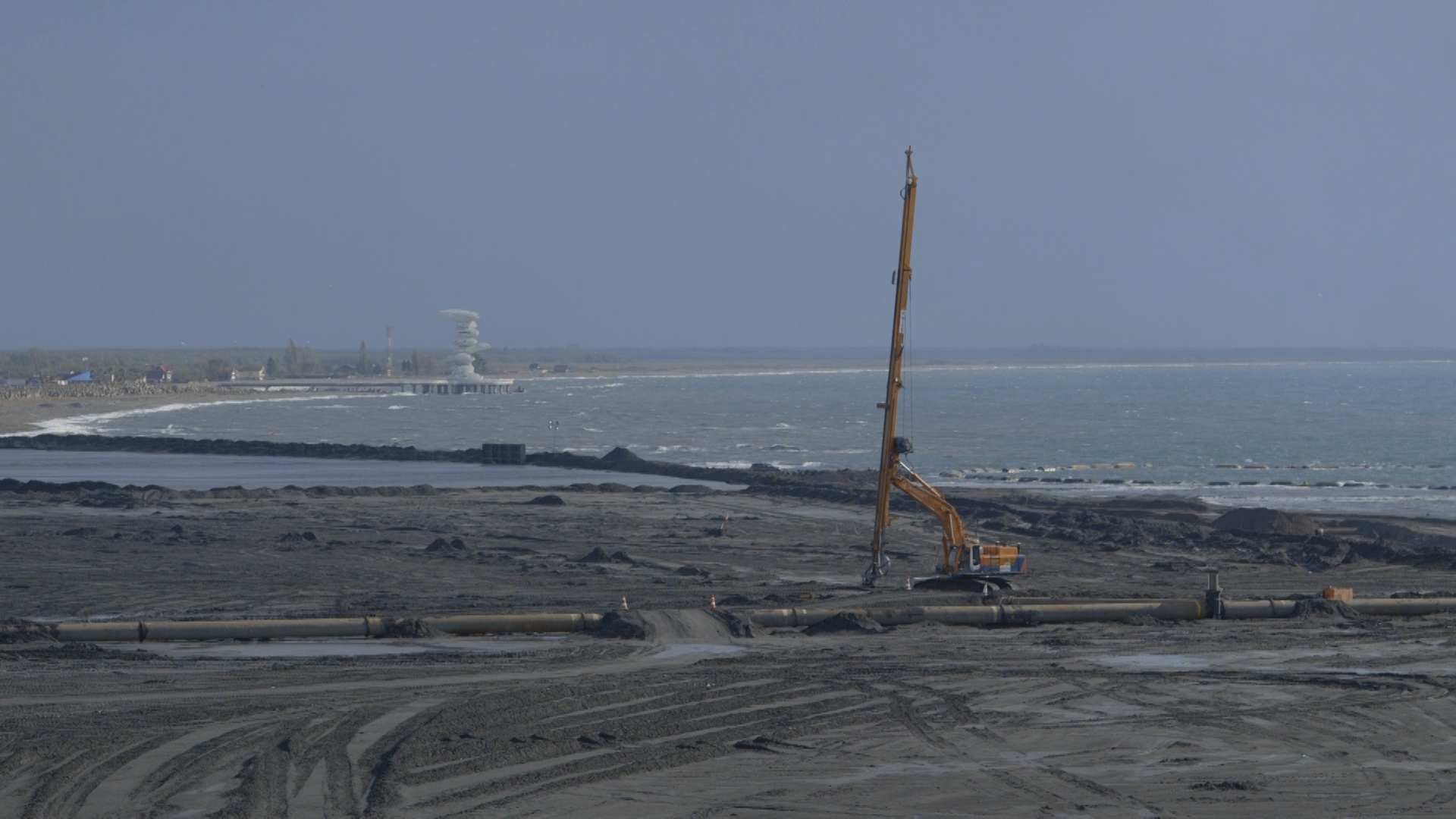“Reclamation,” Lexico.com, ➝.
This article emerges from a conversation between an artist, Tekla Aslanishvili, and a historian of science, Orit Halpern. From 2016 to 2019, Aslanishvili set out to document the story of the Anaklia Deep Sea Port and city; this article is a response to that project.
“Dredging work in Anaklia Deep Sea Port marine works awarded to Van Oord,” Dutch Water Sector, July 8, 2018, ➝.
Ana Dumbadze, “World’s Largest Dredger ‘Athena’ Pumps 5 million m3 of Sand at Anaklia,” November 12, 2018, ➝.
Thus, the Chinese are only the latest in a group of possible partners ranging from Israel to Japan.
Teona Absandze, “Our political team is the initiator of the Anaklia deep-water sea port idea,” FactCheck, March 5, 2018, ➝.
"Georgia/Abkhazia: Violations of the Laws of War and Russia's Role in the Conflict," Human Rights Watch, March 1, 1995, ➝.
“Development of Ports” (archival footage), Eduard Shevardnadze Center, June 5, 2019, ➝.
See Nikoloz Japaridze, "Material Differences," Artforum 51, no. 8 (2013): 222–24.
See “Development of Ports.”
Teimuraz Gorshkov and George Bagaturia, “TRACECA—Restoration of Silk Route,” Japan Railway & Transport Review 28 (September 2001): 51.
“History of TRACECA,” The Transport Corridor Europe Caucasus Asia, n.d., ➝.
Gerard Toal, Near Abroad: Putin, the West, and the Contest Over Ukraine and the Caucasus (New York: Oxford University Press, 2017), 104; “Overview,” The World Bank in Georgia, World Bank, October 18, 2019, ➝.
Wikipedia, s.v., “Rose Revolution,” last updated December 5, 2019, ➝.
“Mikheil Saakashvili in Anaklia,” YouTube video, August 22, 2011, ➝.
This observation is indebted to the collaborative work with the researcher Evelina Gambino.
See Tamta Khalvashi, “The horizons of Medea: Economies and cosmologies of dispossession in Georgia,” Journal of the Royal Anthropological Institute 24, no. 4 (December 2018).
In the same year the president laid the foundation for the city by creating a symbolic urban triangle, composed of two architectural entities connected by a 200-meter-long Palm Avenue. In addition, a promotional state-funded music festival called “Gemfest” was launched in Anaklia in the immediate vicinity of the border with Abkhazia. The festival has never made money, but has generated its own architectural remains, which were designed to perform fun and modernity for imaginary observers from the other side of the border. Evelina Gambino talks about the performative role of architectural frictions in Anaklia in an interview for Tekla Aslanishvili’s forthcoming documentary film, Algorithmic Island.
Conti raises the money for, and manages financing, engineering, and construction of, large-scale infrastructure projects in numerous sectors, particularly logistics, energy, real estate, and agriculture. It is one of the largest privately held corporations in the United States. “Anaklia Development Consortium Selected to Build a Deep Sea Port in Anaklia,” The Finchannel, February 10, 2016, ➝.
Leman Zeynalova, “Phase 1 of Georgia's Anaklia Deep Sea Port finalizing financial closure,” MarketWatch, April 4, 2019.
“Info,” Anaklia Development Consortium, ➝.
“Special Economic Zone,” Anaklia Development Consortium, ➝.
Ian Volner, "J. Mayer H. Architects in Georgia," Journal of the American Institute of Architects, December 5, 2013, ➝.
See Tekla Aslanishvili and Evelina Gambino, "Remaking Anaklia: Landscapes of Trial and Error across the New Silk Road," in Werkleitz Festival Catalogue (2018).
See Susan Buck-Morss, The Dialectics of Seeing: Walter Benjamin and the Arcades Project (Cambridge: MIT Press, 1991), 78–79 and 110–111.
Keller Easterling, Medium Design, (Moscow: Strelka Press, 2018), 14.
Easterling, Medium Design.
The meeting was held for the MA students of Applied Design and Architecture at Oxford Brookes University, and will be featured in Tekla Aslanishvili’s forthcoming documentary film Algorithmic Island.
“Government Completes Buying off Lands in Anaklia—How Many Millions Go to Samegrelo,” Caucasus Business Week, September 27, 2017.
This information is sourced from video-interviews and field notes by Tekla Aslanishvili.
Evelina Gambino, “The New Silk Road and Logistical Geopolitics,” Society & Space, March 27, 2018, ➝.
Public meetings organized by ADC in Zugdidi and Anaklia, September 3–4, 2017.
Since May 2019, in relation to another labor-related project, Anaklia EduHub, mainly local female jobseekers have been trained in English, computer programming, entrepreneurship, business management, and housekeeping. The project was organized as part of an Anaklia Community and Economic Development (ACED) Program aimed at ensuring a qualified workforce for the future service village, which should support the functionality of port and Anaklia City.
Ana Dumbadze, “Gov’t to Search for a New Investor for Anaklia Port,” Georgia Today, January 9, 2020, ➝.
For a more planetary scale discussion of the BRI and changing economies of extraction and logistics, see Martin Arboleda, Planetary Mine: Territories of Extraction under Late Capitalism (New York: Verso, 2020).
From an interview in Algorithmic Island.
Japaridze, "Material Differences," 224.
Japaridze, "Material Differences," 224.
See Buck-Morss, The Dialectics of Seeing.
